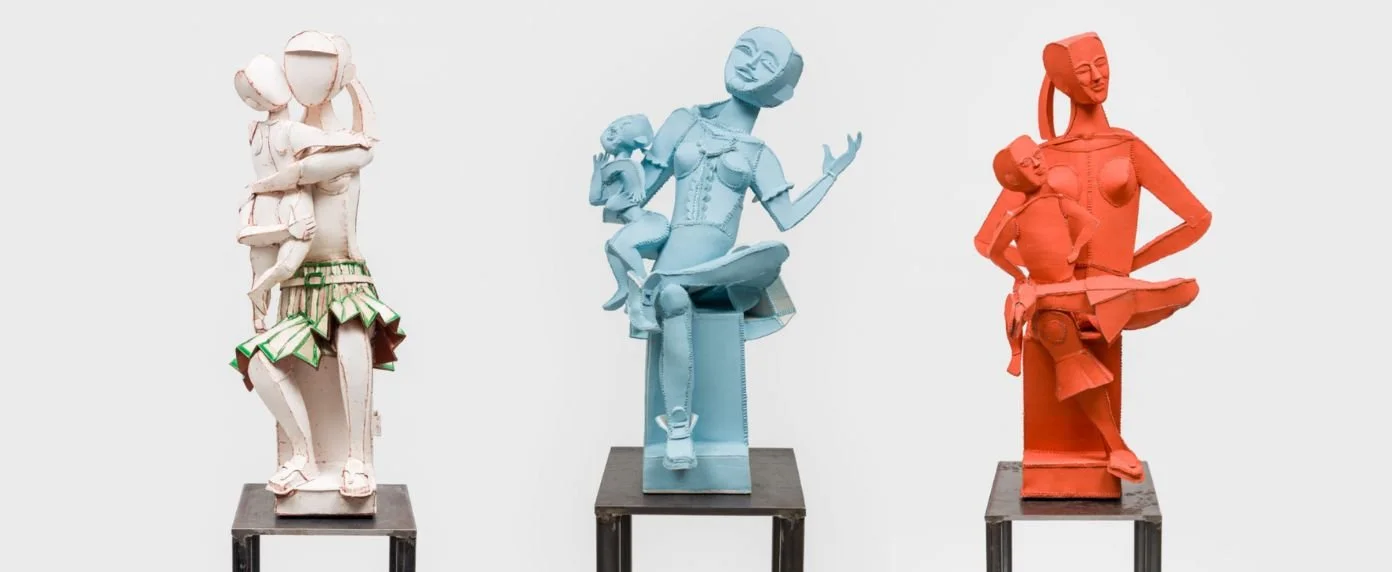Three Bridges and Three Madonnas: Kent Roberts at 600 California St / Ann Agee at Jessica Silverman
Halfway up California Street between Kearny and Grant, in a snippet wedge of a park between two towers, Kent Roberts' Three Bridges (1992) climbs up a double-set of steps—a riddle in poured concrete and metal. Miniaturized, human-scaled models of interlaced industrial infrastructure: a poured concrete aqueduct runs beneath a railroad trestle in concrete and steel that tucks underneath two columns of what seems to be a highway overpass, in bronze.
Roberts' soft punchline is that we don't know how to look at bridges except in transit. By playing with medium—bronze for a ramp of the 280, like a mundane Riace warrior—he evokes Le Corbusier's observation that "American engineers are not artists, but they are geniuses." Carrying water, trains, and automobiles, the vascular system of California is reduced to a picturesque folly in the maze of SF's Fi-Di. Miniaturized and fragmented, the simple beauty of these sculptures becomes tenderly evident, and yet you don't know what else to do with it—which seems to be the point.
Up the hill and around the corner on Grant at Jessica Silverman Gallery, three Madonnas by Ann Agee (all 2025) ignite a similar perplexity. Included in "Her Dark Materials," a group meditation on medium wherein every object trickily smuggles its own double, Agee's three figures are the smallest in the room but steal the show.
Three pairs of women—each presumably a mother and child (clearly daughters here)—all some variant of fired clay, sit on boot-shaped thrones, resting on felt, on steel pedestals. One, Red Hot Hands on Hips, Madonna, burns a bright cadmium red, like some anti-Judd that still adheres to his laconic idea that, in art, "a work needs only to be interesting." And how. In another, Green Pleated Skirt Madonna in glazed white earthenware, the pair of faceless figures recall early 20th-century, mostly French, precedents: the lines of Matisse's dancers of 1910 with a kind of Duchampian send-up of cubism on a staircase.
What Agee does that these earlier artists didn't care to do was emphasize intimacy through embrace: their arms interlock and faces press against each other like a heart. Also, this one has a small, peculiar little shelf on the side of the seat—something sorely lacking in the 20th-century European avant-gardes.
In equal parts devotional and domestic, scrupulously art-historical and toy-like, one senses Mary Cassatt in the tender contiguities of bodies that sometimes whirl in Shiva-like arabesques. Agee's funny reliquaries refuse to cede to one thing or the other—playful monuments to matrikin traditions. The seams, folds, and false bottoms of ceramics reveal themselves trickily. That red-hot hat atop the eponymous Madonna is cardboard, not clay. Agee masterfully prompts double takes, where familiarity drops and you feel delightfully dumb. Call it wonder.
If Roberts' bridges compress the history of how we got to and how we get around California—water, rail, freeway—Agee's Madonnas condense the history of our genesis in a different sense: the matrilineal facts of birth and care. Both works invite questions of origin and passage. My stock definition of art is anything that grabs your attention without telling you what to do with it. In their own odd ways, Roberts and Agee both succeed by this criterion with a presence that makes you triple-take, then wonder where we all may end up.
Three Bridges is permanently installed at 600 California Street, while "Her Dark Materials" closes on October 25, 2025. See them together if you can.

